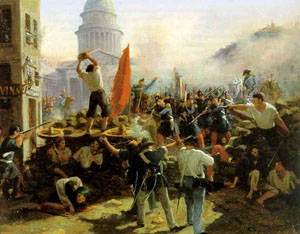1. Horace Vernet’s painting depicting the fighting near the Pantheon during the “June Days” in Paris in 1848
Questions
Description and Analysis
- The cause of the workers’ uprising in Paris in June 1848, was the liquidation by the new government the “national workshops” considered unproductive and a breeding ground for subversive political slogans.
- On June 22, 1848 56 MPs went to meet the Minister of Labour Mari, led by Louis Pujol. The government had no intention to fulfill their postulates. At the Place de la Bastille L. Pujol organized a meeting, during which he called for armed struggle. On the Bonne Nou-velle street workers set up the first barricade. The rebels seized the workers' districts: St. Dionysius, Saint Anthony, Hal Quarter, part of the Latin Quarter. The workers flied the red flags, calling for social reforms, more work, improvement of their living conditions, ending exploitation and the right to organize. On June 23 the National Assembly has en-trusted to General Louis Eugène Cavaignac command of the garrison of Paris, giving him emergency powers. The insurgents were poorly armed. The workers were aware of the fact that stood little chances agaist the army. The aim of the fighting was to save the honor and protest against government policy. The slogan of those fighting was: “Bread or lead!”. Street fighting was very fierce, despite being poorly armed the insurgents were determined to fight to the end. Several battalions of the National Guard joined the insurgents. Repub-licans participating in February in overthrowing the July monarchy, now distanced them-selves from figting workers‘. The last barricade on the outskirts of St. Anthony Quarter was taken down on June 26.
- The government, backed by the Parisian bourgeoisie, with the help of the army crushed the workers' uprising. 4 thousand workers were killed, 25 thousand of people were im-prisoned, of which 15 thousand were convicted for participating in the clashes and sent to work in the colonies. Louis Bonaparte, a nephew of the Emperor Napoleon, took advan-tage of the loss of support by the republican government. He won presidential elections held on 10 December 1848 by popular vote, the victory he owed to the support of peasants, still loyal to the Napoleonic tradition. He also gained the votes of some of the burghers, for whom he was the guarantor of order and social peace, and workers disap-pointed with the republic.
Geographical/Historical Context
In Paris, street fighting lasted from 22 to 24 February 1848. Louis Philippe abdicated and the provisional government took over, declaring France a republic and introducing a democratic constitution. The new authorities limited working time to 10 hours in the capital (11 hours elsewhere) and organized "national workshops" for almost 100,000 unemployed Parisians - companies that were organized by top-down directives, with no regard for actual market needs. Meetings were allowed and censorship was completely abolished. The government also introduced universal suffrage and guaranteed political freedoms. Moderate Republicans and monarchists won the elections to the unicameral Assembly. Radicals received the least votes. When the new government abolished the workshops and decided to send part of the unemployed to work in the province in districts inhabited by the poor and the proletariat a new uprising, called "days in June" broke out on June 22, 1848. It was brutally crushed by the military and the police.
Links
http://pl.wikipedia.org/wiki/Plik:Lar9_philippo_001z.jpg painting by Henri Felix Emmanuel Philippoteaux entitled Lamartine in front of the Town Hall of Paris rejects the red flag on 25 February 1848.





Presentation
Horace Vernet (1789 - 1863) – a French painter and graphic artist, representative of the naturalist movement. He depicted Napoleonic battles, military, battle, and hunting scenes and painted portraits. He was the director of the French Academy in Rome. He is also the author of lithographs and woodcuts illustrating the book by L. de l `Ardèche History of Napoleon (1839). In his school in Rome he educated many Polish artists like January Suchodolski and Joseph Brodowski. He died in Paris and was buried in the Montmartre Cemetery. His major works include: The Battle of Jammages (a huge battle-piece is located in Versailles), Battle of Vadlmy, Death of Prince Jozef Poniatowski, the Battle of Wagram, Battle of Jena, The Slave Market, Battle of Isly, Soldier from Waterloo, Mazepa.
Pantheon in Paris - the former church of St Genevieve in the Latin Quarter, designed by Jacques Germain Soufflot. Its construction was completed in 1789. The Pantheon in Paris is a classical building on a Greek cross plan with a central dome and four side, flattened domes with a pillared portico entrance. It is modeled on the Roman one. Since 1791, it is the resting place of many famous Frenchmen and French women. The crypt of the Pantheon contains the tombs of Voltaire, Rousseau, Honoré Mirabeau, Victor Hugo, Emile Zola, Jean Jaures, Louiss Braille, the inventor of a system used by blind people for reading and writing, physicists Paul Langevin, Pierre Curie, Marie Sklodowska-Curie, Marcelin Berthelot, a chemist , General F. Marceau, Jean Moulin, the Resistance leader in World War II. Twice an attempt to restore its religious function was made, but since 1885 it has been a mausoleum.